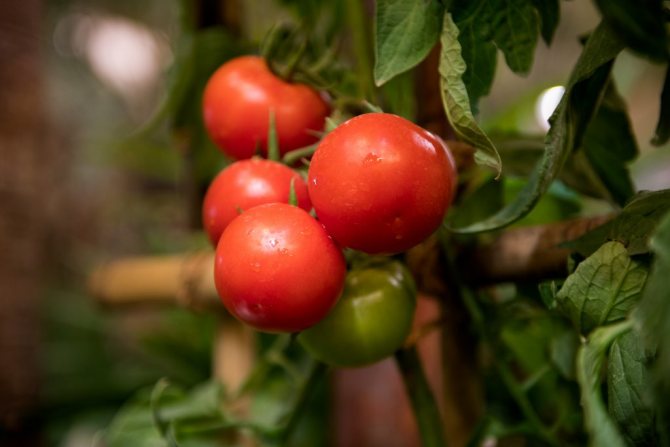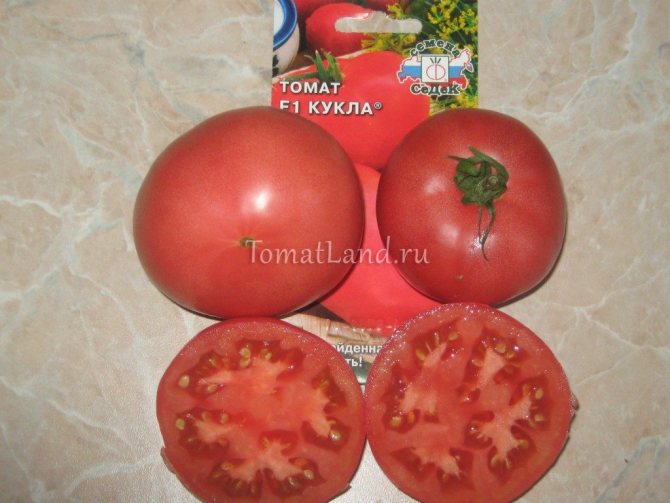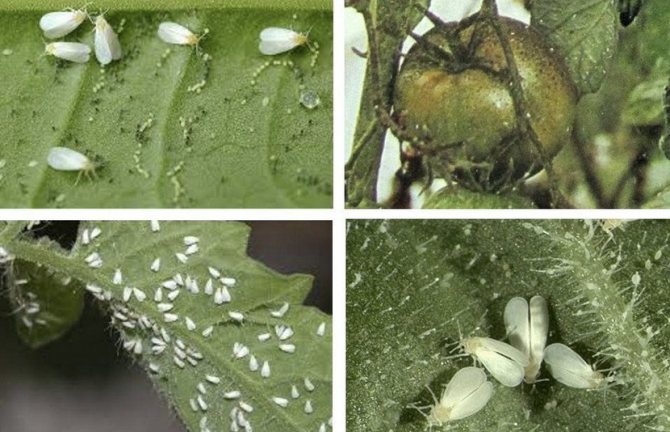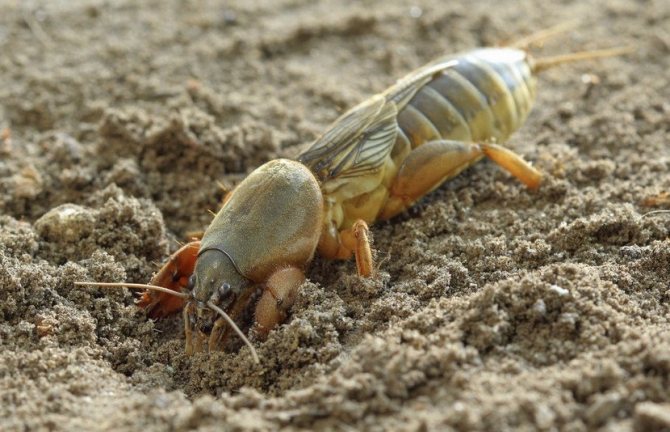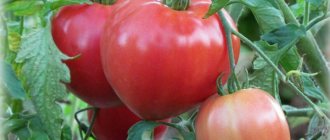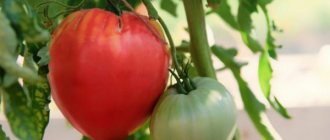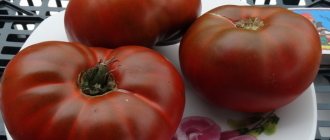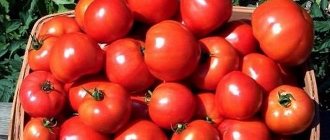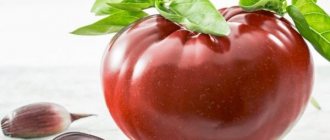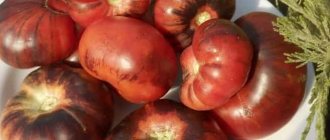Home / Garden / Tomatoes
Back to
Published: 18.05.2018
Reading time: 5 min
0
391
Hybrid forms of tomatoes are distinguished by their yield and disease resistance. For regions with harsh climatic conditions, such tomatoes are the best fit, so the popularity of the Kukla F1 variety is understandable.
- 1 Doll F1 - at the top of the charts
- 2 Growing a determinant hybrid: what to look for 2.1 Seedlings from "A" to "Z"
- 2.2 Caring for tomatoes in the greenhouse
Description and characteristics of the variety
Tomato variety Doll f1 is characterized by an early ripening period and belongs to a productive and persistent determinant type. On the basis of this variety, the Kukla Dasha tomato was bred - they are similar in appearance, but differ in taste. The first fruits can be obtained as early as 85 days. The bush of tomatoes is undersized, the height of the stems reaches 70 cm. A plant with small leaves and moderate foliage. The tomato hybrid was bred by domestic agro. Productivity from 1 sq. m is up to 9 kg. The mass of fruits reaches 350 g, tomatoes are pink in color, round in shape, the pulp is dense and fleshy. A distinctive feature is the high sugar content. Doll f1 tomatoes have universal application, and they can also be grown in open and closed ground.
Growing features
Agrotechnical techniques for this variety are standard. Planting seedlings in spring using special containers or mini-greenhouses. To speed up the processes - growth stimulants.
After planting in a permanent place, everything is according to the usual scheme - loosening, watering, mulching, feeding.
As a top dressing you can use:
- Organic fertilizers.
- Yeast.
- Iodine.
- Hydrogen peroxide.
- Ashes.
- Ammonia.
- Boric acid.
The main pros and cons of tomato F1 Doll
Doll Tomatoes are a fruitful and early ripening variety with good immune protection. О indicates that the variety belongs to the first generation hybrids. Based on this, the plant has a lot of undoubted advantages:
- flower brushes appear early;
- since the fruits ripen rather quickly, this reduces the risk of late blight disease;
- the harvest gives excellent results at the same time;
- the hybrid can be grown both outdoors and in a greenhouse;
- fruits contain a large amount of sugar;
- tomatoes are used for salads, as well as preservation;
- tomatoes tolerate transportation and long-term storage well;
- fruits do not crack during heat treatment;
- strong seedlings and high immunity;
- germination rate up to 98%.
At the same time, one cannot fail to mention the shortcomings of the modern hybrid. The collected material does not retain the genetic characteristics of the primary material, so the seeds will have to be purchased every year. Even small bushes need a garter. In addition, the crop can only grow on fertile soil. With untimely watering, the quality of fruiting deteriorates.
Advantages and disadvantages
Based on the description of the variety, the following advantages of the Doll tomatoes can be distinguished:
- good productivity;
- early maturity;
- versatility of the use of fruits;
- disease resistance.
Disadvantages: weak fruit aroma, inability to collect seeds.
():
The seeds can be collected, but it is undesirable to use them for further sowing, since in the second generation the maternal traits are split and the resulting plants will have unknown characteristics.
Receiving and planting seedlings
Sowing seeds for seedlings is carried out at the end of March, and planting of seedlings in a permanent place is carried out after 40 days for the greenhouse and after 60 for open ground.
See also Description and characteristics of the Pink Elephant tomato
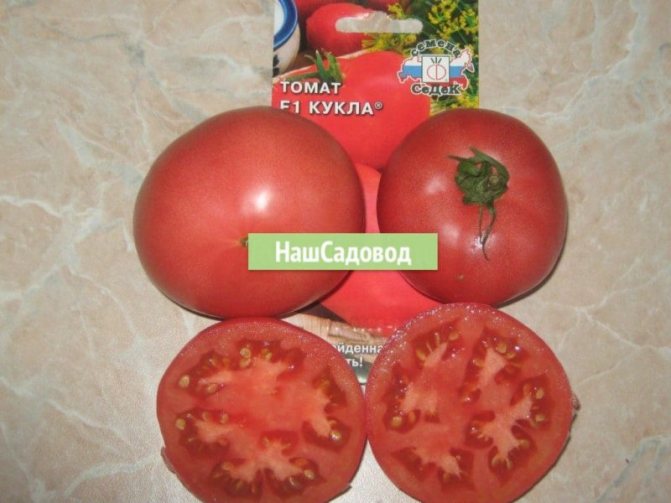
Seedling rules:
- Hybrid seeds do not need to be pre-disinfected, since they undergo the necessary processing before going on sale.
- Large, shallow containers are selected for sowing. The soil can be purchased at a specialty store or you can prepare the soil yourself. To do this, take sod land, black soil, humus and a small amount of sand.
- The bottom of the container should be with a drainage layer - for this, expanded clay is poured so that excess liquid does not accumulate. This is a preventive measure for the development of a fungal disease.
- Soil is poured on top of the drainage layer and small depressions of 1 cm are made. Further, the seed is placed in the grooves, observing a distance of 3 cm. The seeds are sprinkled with the rest of the soil and irrigated with water using a spray bottle.
- The seed containers are covered with foil or glass to create a greenhouse environment. Crops should be ventilated regularly.
- After that, the crops are harvested in a well-lit and warm place. Spraying is carried out every two days.
As soon as the first gatherings appear, the shelter is removed. The temperature is lowered to 19 degrees. Watering is carried out as the soil dries out. The picking of seedlings is carried out when two true leaves appear. At the same time, the root is pinched by 1 cm. The transplanted plants are planted in peat glasses and watered at the root. Two weeks before planting, the seedlings need to be hardened by taking them outside.


Seedling planting technology:
- For planting, choose a light fertile soil where cucumber, garlic or cabbage used to grow.
- Rotted manure or compost is introduced in advance.
- The depth of the holes corresponds to the length of the root system, the distance between them is 70 cm.
- Overgrown soil is planted at an angle of 45 degrees.
Then it remains only to water the seedlings abundantly and tie the plants to the support.
Reviews of gardeners
Tamara, Ryazan: “A good tomato, I liked the even, identical tomatoes, as in the photo, weighing 100–150 g. The taste is ordinary, with a slight sourness. The fruits are perfectly stored and are suitable for preservation. "
Valentina, Moscow region: “The fruit tastes sweet and sour tomato, the skin is strong, does not crack. Only the size of the hybrid did not impress ”.
Svetlana, Penza: “I grew the Doll in a greenhouse and in the open field. There were no problems with leaving. In the brushes, 6 fruits were formed, identical and even. Tomatoes are hard and tasty, suitable for salads and canning. The yield is high. "
Further care of the plant
The tomato variety requires a garter and moderate pinching. Considering that the plant is not a standard plant, it will need to be tied to a vertical support. For accelerated ripening, it is recommended to remove the leaves remaining at the bottom after removing the lower brush. Watering is carried out with heated and settled water, trying not to get on the leafy part and the stem. The soil under the tomatoes should be in a moderately moist state, preventing liquid stagnation. At the beginning of the growing season, fertilizing with fertilizers that contain nitrogen will be required. In addition, the beds must be weeded regularly no deeper than 10 cm.
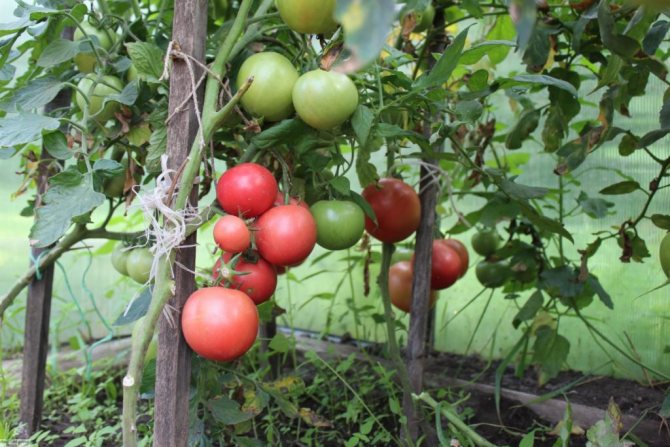

To reduce the frequency of weeding and retain moisture, a vegetable garden with tomatoes is mulched with peat, sawdust or straw. Loosen the soil from time to time. Two weeks after the first feeding, you will need to re-apply the fertilizer mixture. This time they use wood ash.To accelerate the ripening of the crop, the plantings are irrigated with a solution of humates. Top dressing is applied at the root along with watering. It is important to eliminate in time weeds that clog the plant and attract harmful insects.
See also Cow's Heart Tomatoes: yield and cultivation features
Planting seedlings


The area for growing tomatoes is chosen light, well-ventilated. The soil should be light, nutritious, neutral. Precursors for them can be cucumbers, cabbage, garlic, onions, parsley. Tomatoes are not planted after nightshades: potatoes, eggplants. They share diseases and pests, so they can easily be transmitted to newly planted plants.
The air temperature for planting in the greenhouse must be at least 12 ° C. It is necessary to plant on the street only after the threat of return frosts has passed. Plants are transplanted, the height of which has reached 20 cm.
Water before planting so that the roots are less damaged during transplantation.
Pits are prepared at a distance of 70 cm from each other. The minimum is 50 cm, but in this case, care will be complicated, possibly affecting by diseases due to thickening. The depth of the pits depends on the size of the plant root system. If you have to plant overgrown seedlings, they dig longitudinal holes, water and lay the plants at an angle with leaves to the north. Water is poured into the hole 0.5 liters or a little more.
Diseases and pests
Tomato Doll f1 is a stable hybrid with a fairly strong immune defense. However, if the agrotechnology of growing is not followed, the plant may be exposed to such dangers:
- late blight is a fungal disease, which is accompanied by darkening of the leaf part. The affected plant is treated with Fitosporin;
- mosaic is a viral infection in which the leaves curl up into a tube. For treatment, Karbofos is used;
- whitefly are small parasites with white wings that feed on plant sap. Confidor is used to fight.
- Medvedka is a large brown insect that destroys the root system. Thunder is used to eliminate the parasite.
- scoop - a butterfly caterpillar that eats away the stalks and leaves of the culture. To fight, use the drug Thunder.
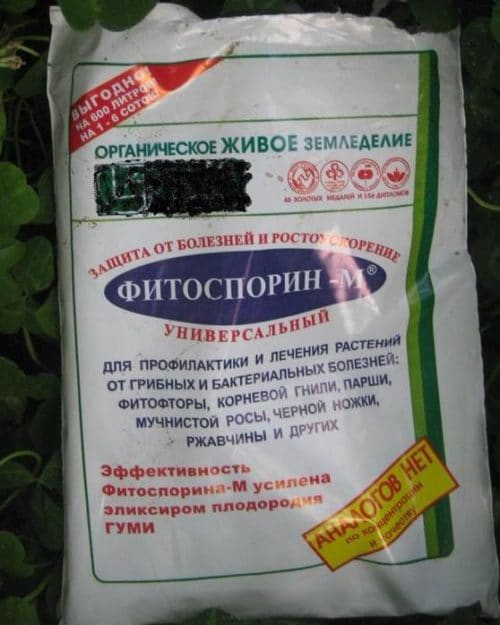

For prophylaxis, periodic spraying of plantings with insecticides, as well as folk compositions, is used. The beds are irrigated with ash infusion or potassium permanganate solution. With an invasion of pests, bushes with tomatoes are sprayed with infusions of bitter herbs (wormwood, celandine). A soap solution is also effective against parasites. In addition, you need to observe crop rotation, remove plant residues on time, regularly loosen the soil and follow the recommendations for watering.
Yield
Productivity from 1 tomato plant is 4-4.5 kg. From 1 m2, 9-10.5 kg are collected.
Due to its yield, the tomato is popular with gardeners. Observance of correct agricultural technology, as well as a correctly chosen greenhouse, will provide a yield of up to 8 kg of tasty fruits from 1 m2.
The doll Masha tomato needs good regular feeding to get an excellent harvest.
Since the hybrid is recommended for growing in greenhouse conditions, all regions of Russia are suitable for its cultivation, except for the regions of the Far North. The central and more northern regions are distinguished by slightly lower yields. The southern regions (Astrakhan Oblast or Krasnodar Krai) are optimal for growing the Masha Doll hybrid.
Harvesting and storage
Harvesting should be done every day. Fruiting begins in early July. For longer storage, the tomatoes should be removed along with the stalk. Tomato variety Doll f1 is stored for a long time due to its dense peel. It is recommended to store the harvested crop in a cool and dry place. To improve the keeping quality of tomatoes, place the fruits in a wooden box with sawdust.The fruits can be harvested at the technical maturity stage, as they tend to ripen in the sun. The harvested crop is suitable for commercial use as it tolerates transportation well.


Planting seeds
Buy seeds in a store, they must be fresh enough. Before sowing, they must be soaked, previously wrapped in cloth, in clean water. They are sown in March-April, 40-45 days before planting in the greenhouse, in boxes 4-5 centimeters deep, with soil “for seedlings”.
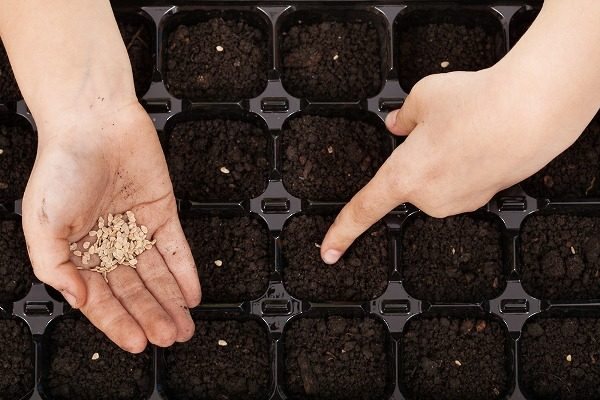

Seeds are planted in March-April.
The seeds are lowered to a depth of 0.7-1.0 centimeters, sprinkled with earth, watered and covered with a film, creating a mini-greenhouse. There should be a distance of 2-3 centimeters between the seeds. The greenhouse should be ventilated periodically. When the sprouts have two leaves, they can be actively watered.
You can dive sprouts into separate containers or into the same box, but at a greater (5-7 centimeters) distance.
After the expiration of time, they are planted in a greenhouse, where the Doll gives the best harvest. Rely on common sense, you do not need to pay attention to the lunar calendar. If the greenhouse is small, the tomatoes can be left in boxes and kept inside the greenhouse for a while, and then transplanted into the ground. Water before planting. You need to plant strong shoots, about 30 centimeters high, at a distance of 50 centimeters from each other. At this distance, it will be most convenient for them to care for and harvest.
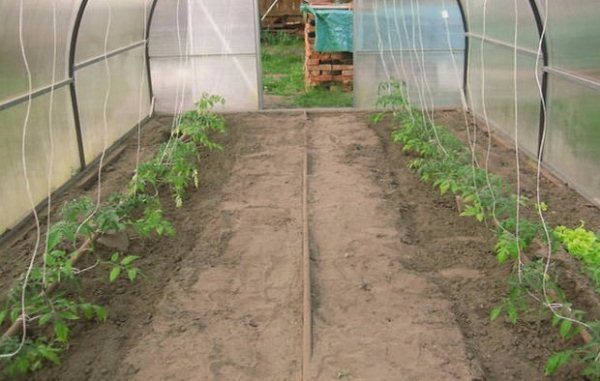

The best yield indicators are the tomato variety Doll shows in the greenhouse
In 7-12 days, after they take root and take root, tomatoes can be watered (preferably in the afternoon) under the root, loosened (to a depth of about 5-10 centimeters) the ground and fertilized.
Watering should not be carried away, it is enough just to monitor the soil so that it does not dry out.
If this is not possible, then the soil can be mulched, for example, with sawdust, straw or peat - this will reduce moisture evaporation.
After the appearance of the first flower cluster (which usually follows 5-7 leaves), the tomato is stepson. Grasshopping is necessary so that the plant does not waste energy on extra processes. So the fruits will ripen faster.
How to get a guaranteed crop of tomatoes, regardless of weather conditions?
The first advice to gardeners is not to adhere to the lunar calendar when sowing seeds. The second is not to dwell on just one variety, but to practice several. For example, the Kukla tomato has positive reviews from consumers and gardeners. Hence, it should be chosen. Add to it one or two more varieties that prefer other weather conditions. So you can predict the unexpected whims of nature and are guaranteed to be with the harvest. You need to choose the landing dates with your own mind, and not with the fantasies of an abstract astrologer. The calculation begins with the study of the timing of planting seedlings in the ground, recommended by the manufacturer of the variety. Then, for determinant varieties, thirty days must be taken away from them - this will be the start for sowing seeds, and for indeterminate varieties, forty-five days must be discarded (for the development of seedlings).


